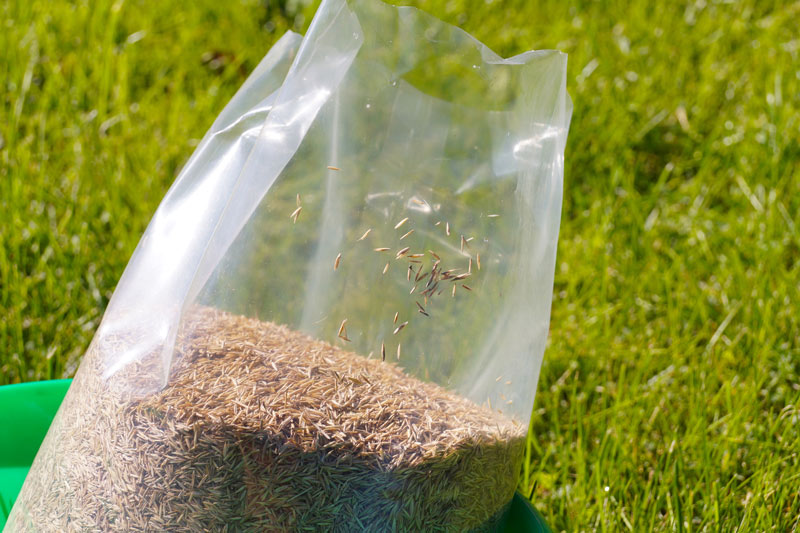
A diminished supply of seed for nearly all golf course grass species has prices high and many superintendents in a pinch. Photo by Adobe Stock
Not long after the start of the new year, Jared Stanek had an inkling he might have more than a little trouble sourcing grass seed this summer.
Stanek, GCSAA Class A superintendent and director of agronomy at Toscana Country Club in Indian Wells, Calif., knew about the pandemic-induced run on residential grass seed caused by the millions of Americans staying at home, staring at their unloved lawns. Another domino fell this past year when Scotts Miracle-Gro reportedly entered into an agreement to purchase the turf division of Columbia Seeds, just one of a handful of mergers and acquisitions that was sure to constrict supply.
“Between those two pieces of information, I realized we had a big problem coming,” says Stanek, a 16-year GCSAA member. “Just doing the math in my head, that’s millions of pounds of seed that’s not available. I went to ownership and said this was probably going to be about a 50% increase in the price of seed.”
At Toscana CC, with a six-figure seed line item and the understanding that wall-to-wall overseeding is an imperative, a 50% cost increase is no small blip. When Stanek took possession of his order in mid-September — after essentially “tearing up” the contract he’d signed back in April anticipating that 50% increase — his bill had nearly doubled. And still he considered himself among the lucky ones: He actually had seed in hand, roughly 160,000 pounds for Toscana CC’s 36 holes, in time for the anticipated early-October overseed.
“We had it delivered, and I changed the locks on the shop door and told security,” Stanek says. “We have security cameras aimed at the doors. Every year, seed theft is somewhat of an issue. This year, since you can’t even really buy seed now, it’s going to be a really tough year. I was very relieved to see the seed come. A lot of guys were trying to get it early this year, but it’s all about getting it in hand. You just can’t really trust it to be here until you see it. I’ve never seen anything like this. Unfortunately, I think there are going to be some golf courses on the outside looking in at this.”
It’s not like they hadn’t been warned. Turfgrass growers and distributors have been sounding the alarm for months.
“Oh, we’ve been sounding it,” says Leah Brilman, Ph.D., director of project management and technical services for DLF Pickseed North America in Halsey, Ore. “It used to be, for some species, you could say, ‘OK, I can’t get as much tall fescue, so I’ll put this in instead.’ But every species was down. You can’t go up in this and down in that in your blends and mixtures. People can think it’s a big conspiracy theory all they want, but you know what? It’s just not there. It’s simple supply and demand.”
“Nothing has gone right in grass seed production for the last year,” adds Adam Russell, director of product development for Mountain View Seeds in Salem, Ore. “For a place chosen for its stability and mild weather, it has been everything but. And with demand staying high, there’s just not enough to go around.”
Which is why sticker shock — perennial ryegrass seems to be the most talked-about, with prices around twice as much as last year, though costs across the board seem to reflect scarcity for nearly all species — may be the least of a concerned superintendent’s worries.
“In terms of availability, it’s a little bit of a scramble,” says Jim Schmid, GCSAA Class A superintendent and director of golf course operations at The Lakes Country Club in Palm Desert, Calif. “At this point, I think most everybody has secured access to the seed they need, but a lot of people might have had to change varieties. Not everybody has gotten exactly what they wanted, but I think most everybody has come up with something acceptable.”
The Lakes CC obtained 120,000 pounds of perennial ryegrass in September in anticipation of an early-October overseed. Schmid paid $1.07 per pound last year, $2 this year.
“We spend over $100,000 in seed, and I think that’s fairly typical for an 18-hole facility, and now you’re doubling that up. That’s a big number to double,” says Schmid, a 17-year GCSAA member. “When we took delivery ... we were excited to have it sitting there, waiting. A lot of people were nervous. ‘Is this stuff going to show up?’ This year, it’s coming down to the wire.”
‘Is this biblical?’
The Great Grass Seed Shortage of 2020/2021 — and, honestly, probably 2022 and maybe into 2023, but more on that later — is, of course, not simple to explain. But as Mountain View Seeds’ Russell alluded to, much of it stems from the industry’s reliance on one small part of the United States to grow a huge chunk of its cool-season turfgrasses.
That Oregon in general — and Oregon’s Willamette Valley, in particular — is a cool-season turfgrass grower’s hotbed isn’t mere happenstance. The region became the “Grass Seed Capital of the World” by supplying around 75% of all the grass seed produced globally. Its mild, moist winters and dry summers, which aid in seed development and harvest, make the valley ideal for all sorts of agriculture, especially turfgrasses.
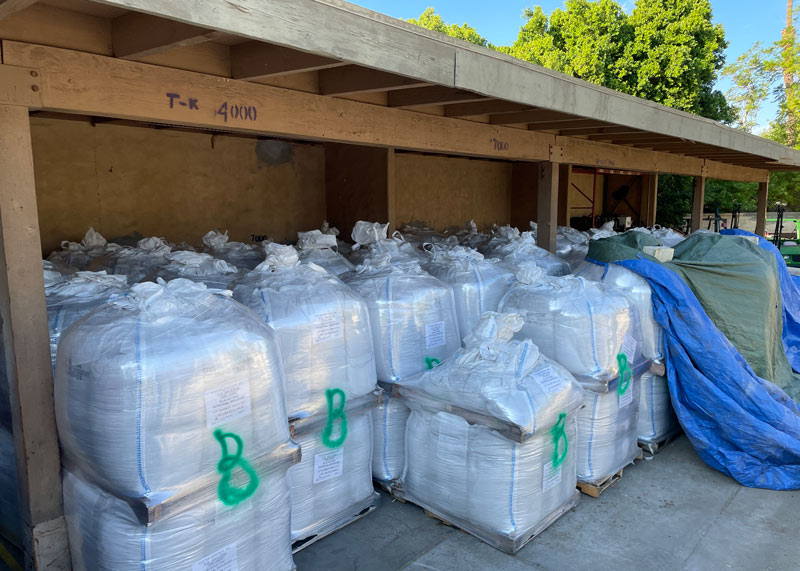
Just in time: 120,000 pounds of perennial ryegrass seed arrived at The Lakes Country Club in Palm Desert, Calif., earlier this month for overseeding in early October. Superintendent Jim Schmid says the cost of the seed increased about 87% over the previous year. Photo by Jim Schmid
Though Oregon growers do produce smaller but significant portions of the U.S.’s Kentucky bluegrass and tall fescues, they produce essentially all of the country’s annual and perennial ryegrasses, bentgrasses, and fine fescues.
The valley’s climate is usually as nurturing as it is predictable. Usually.
Oregon’s recent climatic upheaval started with wildfires in summer 2020. Then came mice and voles. Then an ice storm hit in mid-February 2021, followed by extreme drought conditions and, finally, unprecedented heat, which seared the region at precisely the wrong time.
“The amount of acres planted has been dropping, along with quality of harvest,” Russell says. “We realized there could be a problem, and we started to quietly sound the alarm that this might be a belt-tightening year. But we thought there’d maybe be a 20% decline, not 50%. And the disappointing part about this year is, we thought we had enough acres planted. Maybe. But the cherry on top was the pollination. We had those unprecedented highs, and when it’s that hot, pollen can only sit on the crop so long before it dies.
“You start to think, ‘Is this biblical?’ You know, we didn’t just decide we’d pick this one valley
in Oregon. It was specifically chosen because of stability of climate. This is the perfect valley. There’s something like 230 different crops in the Willamette Valley, like wine grapes and Christmas trees and hemp — and grass seed. And for eight months, really there was no more volatile place in the U.S., maybe the world. It’s hard to overcome wildfire, an ice storm, drought, heat, all in an eight-month span. It’s hard to grow any plant.”
Any one of those factors may have hindered production individually, but collectively, they were crippling.
And those weren’t the only forces at play that made it expensive at best and impossible at worst to source seed this summer.
Remember that pandemic? Even before the elements conspired against the production of grass, work-from-homers were snatching up seed last summer, depleting what the seed sellers had on hand.
“Who knew that a pandemic would cause people throughout the world to decide they were going to plant grass seed?” quips DLF Pickseed’s Brilman.
As grass seed was flying out the door at big- (and small-) box retail stores, distributors had to dip into the reserve. The turfgrass industry relies on carry-over seed to sustain itself. Once the growing, harvesting, drying and, finally, selling are over, the aim is to retain a certain percentage of that year’s crop to have on hand the following spring. However, there was essentially no carry-over of perennial rye, meaning this year’s orders were entirely dependent on this year’s crop — which bodes ill for this year’s carry-over as well.
‘It’s just supply and demand’
One final contributing factor to the seed conundrum was, simply, capitalism.
There’s a considerably larger profit margin in the small bags of seed sold to homeowners than the big bags loaded on pallets and shipped to, say, golf courses. There have been a handful of recent consolidations among seed suppliers, no doubt triggered by the unrealized profits of last summer. When Scotts purchased Columbia, it signaled that all of Columbia’s inventory would shift over to retail, resulting in the immediate loss of a reported 10% to 15% of perennial ryegrass for the industry, which trickles down to tighten the supply of all other cool-season grasses as they replace perennial rye.
The economics of it all is pretty simple from there.
“It’s just supply and demand,” Russell says. “It may be hard for people to believe — and I do feel bad for those superintendents who have to craft a budget. We just blew through that budget — but it doesn’t do us any good. Quite frankly, we’d like the price to go down. If it goes too high, people might say, ‘I just won’t plant grass seed.’ People who might go for a 50% price increase might not go to 100.”
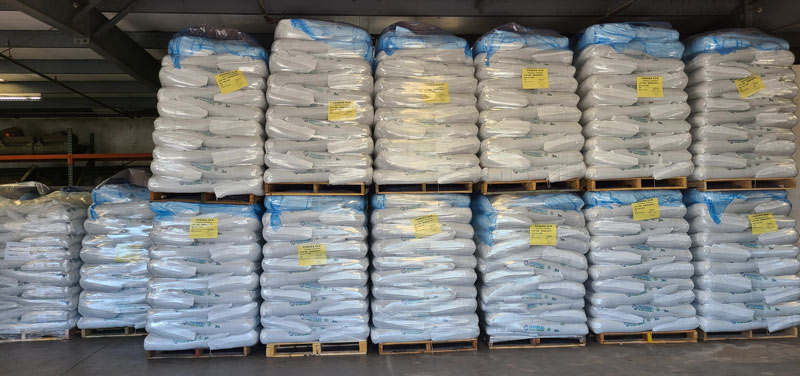
Superintendent Jared Stanek’s seed supply at Toscana Country Club in Indian Wells, Calif. Photo by Jared Stanek
That’s not really an option across the Coachella Valley, for example, where Stanek and Schmid work. There, wall-to-wall overseeding is the norm.
“Absolutely not,” Stanek says, “and I honestly don’t know what the price would have to be to convince the membership not to do it. We’re a high-high-end private club, and our membership fancies our club as one of the nicest clubs in not just the Coachella Valley, but the world. It’s a world-class community property, and for them to change their practices ... it would take a lot. For other courses, that’s a calculation that probably should be started right now.”
“I think for most golf courses down here, our business is members who are traveling down from Canada, Iowa, Michigan, Minnesota,” Schmid adds. “They’re leaving the frozen tundra, and they want to see green grass. I know of a couple of clubs that experimented with limited overseeding, and that was not well received from the membership. Most facilities would rather look somewhere else to cut costs than to reduce their overseeding.”
Though the seed discontent doesn’t discriminate by species or geographic region, it’s probably most jarring for those in the southwestern U.S., where overseeding perennial ryegrass is a common strategy to keep courses pretty when the warm-season grasses go dormant. A recent GCSAA maintenance budget survey showed that, at least among respondents, superintendents in some regions don’t budget for overseeding. In the Southwest, though, 60% of respondents overseed, and that overseed allowance made up close to 4% of the overall maintenance budget for 2021.
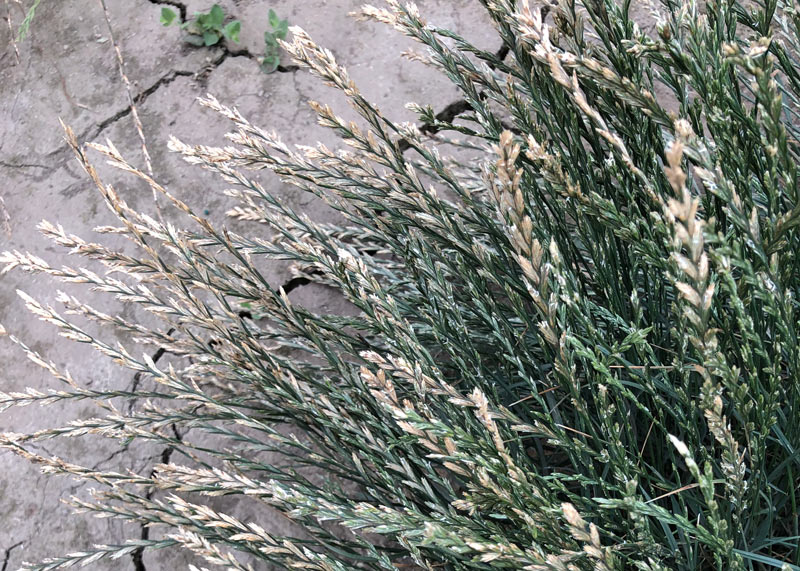
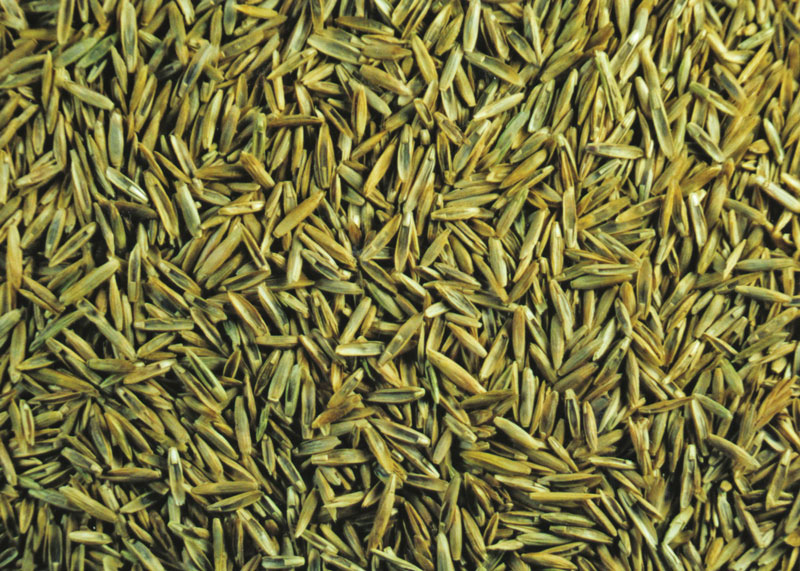
A pretty penny for perennial rye: The seed is fetching around double the price it did last year. Photos courtesy of Leah Brilman
To deal this year, Ernie Pock, GCSAA Class A superintendent and director of agronomy at the 36-hole Grayhawk Golf Club in Scottsdale, Ariz., decided to revert to an old 85:15 blend of perennial rye and Poa trivialis he had used in the past. Though Poa trivialis prices are up too, Pock figures he’ll save between $16,000 and $17,000 by blending.
Still, Pock, a 29-year GCSAA member, planned to take possession of 88,000 pounds of grass seed, enough to overseed one course wall to wall and partially overseed — fairways, green surrounds, tee boxes — the other.
“At Grayhawk, you have to overseed,” Pock says. “Too much money would be lost if you don’t. We have to produce a product our guests are willing to pay for.”
Pock placed his order in March. By mid-September, he was still crossing his fingers.
“I’m dealing with the seed trucks now,” he says. “It was supposed to be here, but it hasn’t even started shipping from Oregon yet. It’s getting a little stressful. I’ve heard of golf courses that were promised seed, and now they don’t have any seed. And I’ve heard of guys where they’re told they’re only going to get 50% of their order. What does 50% do? You can’t just overseed nine holes.”
Strategies for golf course superintendents
What’s a seed-shorthanded superintendent to do?
“First, I’m surprised it’s not getting more press. I don’t know if that many guys and gals aren’t overseeding or what,” muses Steve Gano, a GCSAA Class A superintendent, vice president of operations for International Golf Maintenance Inc. and a 25-year association member.
IGM says it has assisted 183 courses and maintains 477 holes. Naturally, more than a few of its courses are feeling the pinch.
“We have a couple of clubs, they go through 50,000, 60,000 pounds. You double the price, it’s a huge hit to the budget,” Gano says. “I’m told we’re going to get what we’ve requested. However, when it comes time to load the truck, it just might not be available. We have one club that is going to paint. We have some other clubs, for the member base, the director of golf needs to sell rounds, so we’re going to have to just pay the difference.
“Not me personally, but other superintendents are going to try different varieties of perennial rye or lower the seeding rate. In some cases, you can make some adjustments. They’re not great adjustments, but in the end, you’re going to have to make some adjustments.”
Russell has a few tips. Though he predicts the perennial rye constriction has the potential to right itself most quickly, he expects, even in the best case, that issues with price and availability will linger well into 2023. Colorants — or “painting” — may be an option for some superintendents, Russell says. He suggests that buyers look outside their normal supplier network to explore options.
“Make the most of your best management practices and integrated pest management, and I think it’s an opportunity to really look at your grassing programs,” he says. “What can you really get away with? You have to make the decision, ‘Do I really have to seed this area?’ If you get reduced seed, you have to get the best seed you can get. You’d better get the most aggressive cultivars and learn to benefit from doing more with less. For some people, that might be converting areas to natives, or taking areas out of play, or converting cool-season to warm-season.”

Creeping bentgrass. Photo courtesy of Leah Brilman
Brilman recently spoke to the Cactus and Pine GCSA and shared a similar message. She says some superintendents plan to counter by coloring their dormant warm-season grasses; others are experimenting with different cultivars, like turf-type intermediate rye.
“Some of the turf-type annuals people are using aren’t as pretty, but if you want green color, they provide it. Now we’re sold out of them,” Brilman says. “Some guys are painting, but it doesn’t play the same.”
Brilman also spoke about the importance of timing.
“One of the solutions I shared is just to delay slightly when you overseed,” she says. “It was 100 (degrees) in Phoenix. If they just delayed a little bit, they could use less seed and it wouldn’t have as much impact. Sometimes if you just wait, when there’s less bermudagrass competition, you can get by with a lower seeding rate. But some of them are like, ‘No, this is the week I’m going to overseed.’ We’re doing our best to get it to them, but we’re waiting on our growers. It’s going out the door as soon as we get it.”
Seed shortage woes stretch nationwide
Long before the current seed snafu, the cost of overseeding was an issue for many golf courses.
Take Wildhorse Golf Club in Henderson, Nev., for example. While many surrounding courses still overseed wall to wall, Wildhorse GC hasn’t for years.
“We don’t overseed fairways. We stopped years ago because of environmental concerns and the price of seeds,” says Darden Nicks, GCSAA Class A superintendent, Wildhorse’s director of agronomy and a 25-year association member. “I could see other courses go to that possibly too if they can’t get grass seed this year. Some of the high-end clubs ... I don’t know if they could switch out.”
Nicks uses colorants on his fairways in winter. He is still facing a $17,000 grass seed bill, up $11,000 from last year. He rattles off the prices of the three grasses he purchases: ryegrass, up to $2 to $2.20 per pound from $1.02 to $1.18 per pound last year; Poa trivialis, up from $3.50 to $3.95; and fescue, up from $0.95 to $1.16 per pound to $1.90 to $2.15 this year.
“I’m lucky. I got some triv at last year’s prices,” Nicks says. “There are some courses that aren’t going to get any grass seed at all.”
And though seed difficulties might be hitting the Southwest disproportionally, they’re not limited to that region. Just ask Scott Greenseth, GCSAA Class A superintendent at South Fork Golf Club in St. James, Minn. His course is about as far removed geographically and agronomically from the desert Southwest as can be, and even he is feeling the pinch.
“Seed is triple what it was even two years ago,” says Greenseth, a three-year association member. “I was paying $1.59, $1.90 a pound. Now I’m paying around $4. I wanted 400 pounds. I could only get 50.”
And proving the seed shortage isn’t just limited to perennial rye, Greenseth was hoping for low-mow bluegrass.
“No fescue, no rye, just overseeding some low areas that die every year when we have a wet spring,” he says. “It fills in with Poa. I killed it this year and planned to overseed this Labor Day. I didn’t get it, but I assume they’re trucking it in. It’s like everything else. I own the golf course, and I can’t get the pop or Gatorade I want. You get what you get. You order the 16-ounce screw-top cans; they send you the 12-ounce. You tell them what you want, and they send you what they’ve got.”
“We’re depending on nature, and it’s one chance a year,” Brilman says of grass seed. “That’s it. It’s a crop.”
Andrew Hartsock is GCM’s managing editor.